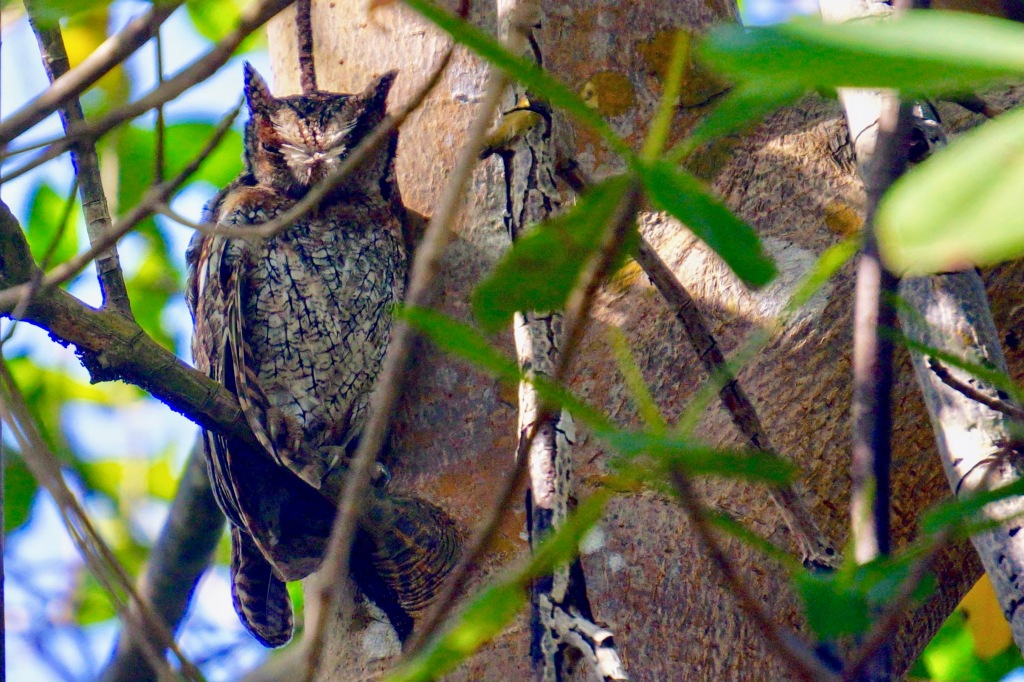Trinidad and Tobago: Caroni Swamp

This post is Part 2 in the series about our trip to Trinidad and Tobago.
✦ ✦ ✦
Our group piles into a boat and the driver leads us through the mangroves and forest at Caroni Swamp. This is the day I am most looking forward to in Trinidad–to see the Scarlet Ibis, Trinidad and Tobago’s national bird. Caroni Swamp is a mix of fresh water herbaceous marshes and brackish mangrove lagoons with natural and artificial channels that meander around the perimeter of the swamp. Instead of hiking through forest to see the birds a boat takes you through these artificial channels to get to the prize–the ibis.
It’s a pleasant way to see birds, especially when you have a troubling, spastic back. (And even when I don’t have a bad back, I always prefer birding by boat over hiking.)

In a jungle there is something always hiding in the trees, such as the Common Potoo, doing its best to impersonate a tree branch stump, a Tropical Screech Owl, camouflaged against a trunk and a boa constrictor, coiled up around a tree limb just above our heads as our boat glides slowly beneath it.



If I were to decide to stand in our boat I could reach up and touch that snake. But why would I? I hold my breath as our boat glides underneath and skip the picture taking. Our new friend John is snapping photos and that’s fine by me. I’ll get that photo when we swap at the end of our tour.
We arrive at the swamp, out in the open, and there are about a dozen other boats filled with birders and tourists, waiting to see the big show. Our boat gently bobs in the water and I watch American Flamingos in the middle of the water, feeding on the shrimp. They’re not a bright pink like I’ve seen elsewhere, like in Mexico, but a light pink. I keep my eyes peeled to the sky looking for the Ibis to come in.
First one comes in.
And then another.
And then all of a sudden a big flock of Scarlet Ibis fills the sky then swoops into the trees to roost. This goes on for the next 20 minutes as more flocks come in. They begin to fill the limbs of the trees, which before served as a hiding place, but now all is out in the open as the leaves become the backdrop of glorious contrast to showcase the red birds.
I snap as many photos as I can, but nothing captures the sparkly red that flutters against the blue sky.
It’s like blood dripping from the sky, and I am pleased with Trinidad so far.



Hello there
So interested to read your latest post about Trinidad. We were due to go there in April 2020 and then April 2021 and this dreadful pandemic has stopped us in our tracks.
We were going to stay at the Asa Wright for a few nights but we are reading it has now closed which is dreadful news; it was our most wanted place to visit.
We are accidental birders too and now it is our passion to travel to see and photograph as many birds as we can. I am always interested to read your posts but this time it has inspired me to start planning again.
We absolutely loved Panama and enjoyed reading about your experiences there and Belize was on our list for this year!
Here’s hoping we all get to travel again soon.
Kind regards.
Carolyn UK
>
LikeLiked by 1 person
Oh, this pandemic has created so many diversions and disappointments for everyone, hasn’t it? I read that Caligo Naturalist Journeys, which was the exclusive booking tour company for Asa Wright is planning to continue trips to Trinidad and Tobago and they assure (on their site) that they have other lodges in the area that can accommodate tours. Hopefully that will work out for you and you will get there!
LikeLike